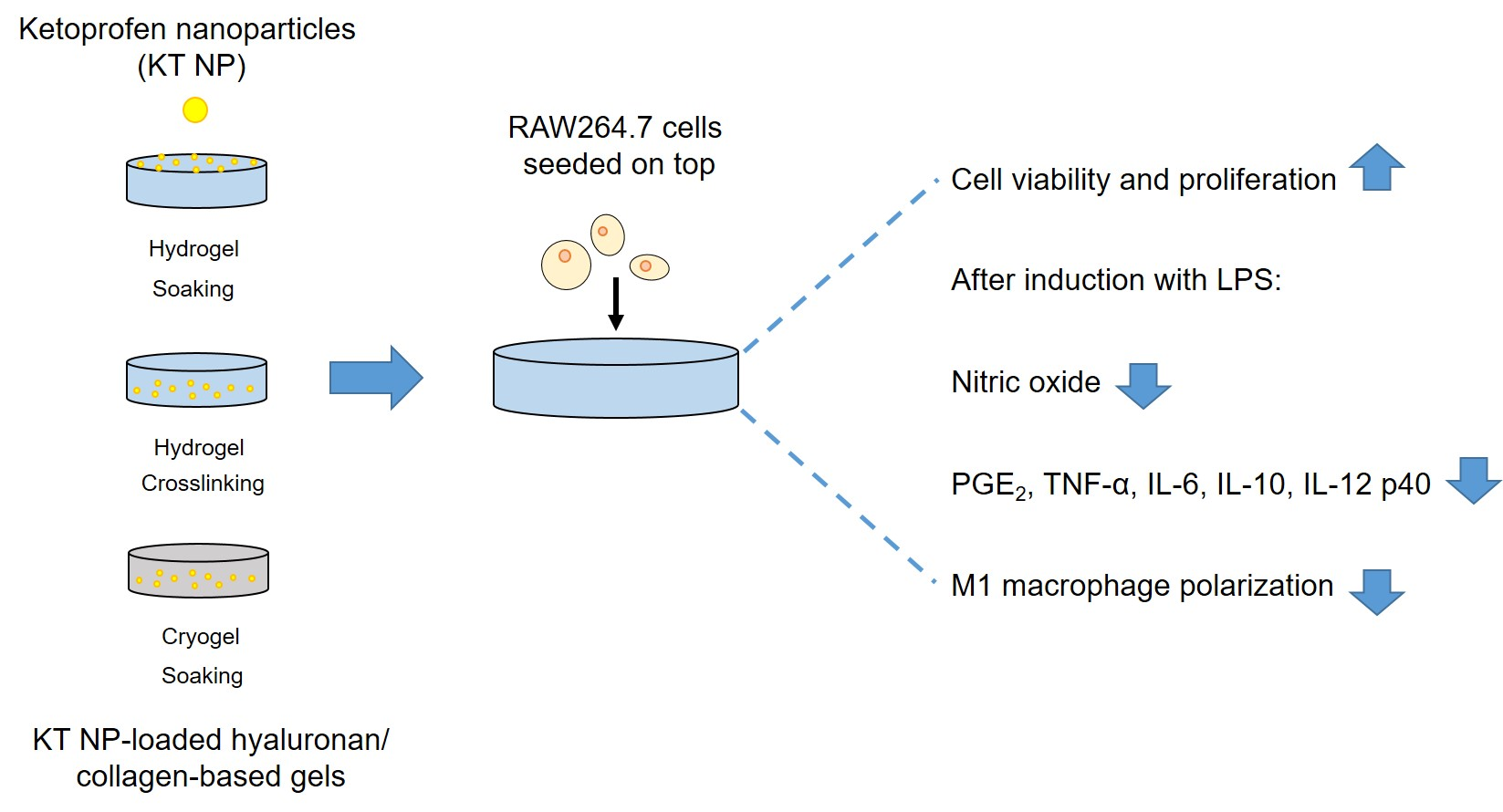Current limitations of wound dressings for treating chronic wounds require the development of novel approaches. One of these is the immune-centered approach, which aims to restore the pro-regenerative and anti-inflammatory properties of macrophages. Under inflammatory conditions, ketoprofen nanoparticles (KT NP) can reduce pro-inflammatory markers of macrophages and increase anti-inflammatory cytokines. To assess their suitability as part of wound dressings, these NP were combined with hyaluronan (HA)/collagen-based hydro- (HG) and cryogels (CG). Different HA, NP concentrations and loading techniques for NP incorporation were used. The NP release, gel morphology and mechanical properties were studied. Generally, colonialization of the gels with macrophages resulted in high cell viability and proliferation. Furthermore, direct contact of the NP to the cells reduced the level of nitric oxide (NO). The formation of multinucleated cells on the gels was low and further decreased by the NP. For the HG that produced the highest reduction in NO, extended ELISA studies showed reduced levels of the pro-inflammatory markers PGE2, IL-12 p40, TNF-α, and IL-6. Thus, HA/collagen-based gels con-taining KT NP may represent a novel therapeutic approach for treating chronic wounds. Whether effects observed in vitro translate into a favorable profile on skin regeneration in vivo will require rigorous testing.
3729048
{3729048:9MXX2GH9}
nature
50
1
1209
http://www.biomateriales.ictp.csic.es/wp-content/plugins/zotpress/
%7B%22status%22%3A%22success%22%2C%22updateneeded%22%3Afalse%2C%22instance%22%3A%22zotpress-5b1992bd7b15b37d68f5690381e258ee%22%2C%22meta%22%3A%7B%22request_last%22%3A0%2C%22request_next%22%3A0%2C%22used_cache%22%3Atrue%7D%2C%22data%22%3A%5B%7B%22key%22%3A%229MXX2GH9%22%2C%22library%22%3A%7B%22id%22%3A3729048%7D%2C%22meta%22%3A%7B%22creatorSummary%22%3A%22Halfter%20et%20al.%22%2C%22parsedDate%22%3A%222023-03%22%2C%22numChildren%22%3A1%7D%2C%22bib%22%3A%22%3Cdiv%20class%3D%5C%22csl-bib-body%5C%22%20style%3D%5C%22line-height%3A%202%3B%20%5C%22%3E%5Cn%20%20%3Cdiv%20class%3D%5C%22csl-entry%5C%22%20style%3D%5C%22clear%3A%20left%3B%20%5C%22%3E%5Cn%20%20%20%20%3Cdiv%20class%3D%5C%22csl-left-margin%5C%22%20style%3D%5C%22float%3A%20left%3B%20padding-right%3A%200.5em%3B%20text-align%3A%20right%3B%20width%3A%201em%3B%5C%22%3E1.%3C%5C%2Fdiv%3E%3Cdiv%20class%3D%5C%22csl-right-inline%5C%22%20style%3D%5C%22margin%3A%200%20.4em%200%201.5em%3B%5C%22%3EHalfter%2C%20N.%20%3Ci%3Eet%20al.%3C%5C%2Fi%3E%20Ketoprofen-Based%20Polymer-Drug%20Nanoparticles%20Provide%20Anti-Inflammatory%20Properties%20to%20HA%5C%2FCollagen%20Hydrogels.%20%3Ci%3EJournal%20of%20Functional%20Biomaterials%3C%5C%2Fi%3E%20%3Cb%3E14%3C%5C%2Fb%3E%2C%20160%20%282023%29.%20%3Ca%20title%3D%27Download%27%20class%3D%27zp-DownloadURL%27%20href%3D%27http%3A%5C%2F%5C%2Fwww.biomateriales.ictp.csic.es%5C%2Fwp-content%5C%2Fplugins%5C%2Fzotpress%5C%2Flib%5C%2Frequest%5C%2Frequest.dl.php%3Fapi_user_id%3D3729048%26amp%3Bdlkey%3DUGRTCG9V%26amp%3Bcontent_type%3Dapplication%5C%2Fpdf%27%3EDownload%3C%5C%2Fa%3E%3C%5C%2Fdiv%3E%5Cn%20%20%3C%5C%2Fdiv%3E%5Cn%3C%5C%2Fdiv%3E%22%2C%22data%22%3A%7B%22itemType%22%3A%22journalArticle%22%2C%22title%22%3A%22Ketoprofen-Based%20Polymer-Drug%20Nanoparticles%20Provide%20Anti-Inflammatory%20Properties%20to%20HA%5C%2FCollagen%20Hydrogels%22%2C%22creators%22%3A%5B%7B%22creatorType%22%3A%22author%22%2C%22firstName%22%3A%22Norbert%22%2C%22lastName%22%3A%22Halfter%22%7D%2C%7B%22creatorType%22%3A%22author%22%2C%22firstName%22%3A%22Eva%22%2C%22lastName%22%3A%22Espinosa-Cano%22%7D%2C%7B%22creatorType%22%3A%22author%22%2C%22firstName%22%3A%22Gloria%20Mar%5Cu00eda%22%2C%22lastName%22%3A%22Pontes-Quero%22%7D%2C%7B%22creatorType%22%3A%22author%22%2C%22firstName%22%3A%22Rosa%20Ana%22%2C%22lastName%22%3A%22Ram%5Cu00edrez-Jim%5Cu00e9nez%22%7D%2C%7B%22creatorType%22%3A%22author%22%2C%22firstName%22%3A%22Christiane%22%2C%22lastName%22%3A%22Heinemann%22%7D%2C%7B%22creatorType%22%3A%22author%22%2C%22firstName%22%3A%22Stephanie%22%2C%22lastName%22%3A%22M%5Cu00f6ller%22%7D%2C%7B%22creatorType%22%3A%22author%22%2C%22firstName%22%3A%22Matthias%22%2C%22lastName%22%3A%22Schnabelrauch%22%7D%2C%7B%22creatorType%22%3A%22author%22%2C%22firstName%22%3A%22Hans-Peter%22%2C%22lastName%22%3A%22Wiesmann%22%7D%2C%7B%22creatorType%22%3A%22author%22%2C%22firstName%22%3A%22Vera%22%2C%22lastName%22%3A%22Hintze%22%7D%2C%7B%22creatorType%22%3A%22author%22%2C%22firstName%22%3A%22Maria%20Rosa%22%2C%22lastName%22%3A%22Aguilar%22%7D%5D%2C%22abstractNote%22%3A%22Current%20limitations%20of%20wound%20dressings%20for%20treating%20chronic%20wounds%20require%20the%20development%20of%20novel%20approaches.%20One%20of%20these%20is%20the%20immune-centered%20approach%2C%20which%20aims%20to%20restore%20the%20pro-regenerative%20and%20anti-inflammatory%20properties%20of%20macrophages.%20Under%20inflammatory%20conditions%2C%20ketoprofen%20nanoparticles%20%28KT%20NPs%29%20can%20reduce%20pro-inflammatory%20markers%20of%20macrophages%20and%20increase%20anti-inflammatory%20cytokines.%20To%20assess%20their%20suitability%20as%20part%20of%20wound%20dressings%2C%20these%20NPs%20were%20combined%20with%20hyaluronan%20%28HA%29%5C%2Fcollagen-based%20hydro-%20%28HGs%29%20and%20cryogels%20%28CGs%29.%20Different%20HA%20and%20NP%20concentrations%20and%20loading%20techniques%20for%20NP%20incorporation%20were%20used.%20The%20NP%20release%2C%20gel%20morphology%2C%20and%20mechanical%20properties%20were%20studied.%20Generally%2C%20colonialization%20of%20the%20gels%20with%20macrophages%20resulted%20in%20high%20cell%20viability%20and%20proliferation.%20Furthermore%2C%20direct%20contact%20of%20the%20NPs%20to%20the%20cells%20reduced%20the%20level%20of%20nitric%20oxide%20%28NO%29.%20The%20formation%20of%20multinucleated%20cells%20on%20the%20gels%20was%20low%20and%20further%20decreased%20by%20the%20NPs.%20For%20the%20HGs%20that%20produced%20the%20highest%20reduction%20in%20NO%2C%20extended%20ELISA%20studies%20showed%20reduced%20levels%20of%20the%20pro-inflammatory%20markers%20PGE2%2C%20IL-12%20p40%2C%20TNF-%5Cu03b1%2C%20and%20IL-6.%20Thus%2C%20HA%5C%2Fcollagen-based%20gels%20containing%20KT%20NPs%20may%20represent%20a%20novel%20therapeutic%20approach%20for%20treating%20chronic%20wounds.%20Whether%20effects%20observed%20in%20vitro%20translate%20into%20a%20favorable%20profile%20on%20skin%20regeneration%20in%20vivo%20will%20require%20rigorous%20testing.%22%2C%22date%22%3A%222023%5C%2F3%22%2C%22language%22%3A%22en%22%2C%22DOI%22%3A%2210.3390%5C%2Fjfb14030160%22%2C%22ISSN%22%3A%222079-4983%22%2C%22url%22%3A%22https%3A%5C%2F%5C%2Fwww.mdpi.com%5C%2F2079-4983%5C%2F14%5C%2F3%5C%2F160%22%2C%22collections%22%3A%5B%5D%2C%22dateModified%22%3A%222023-03-27T20%3A20%3A54Z%22%7D%7D%5D%7D
1.
Halfter, N.
et al. Ketoprofen-Based Polymer-Drug Nanoparticles Provide Anti-Inflammatory Properties to HA/Collagen Hydrogels.
Journal of Functional Biomaterials 14, 160 (2023).
Download


